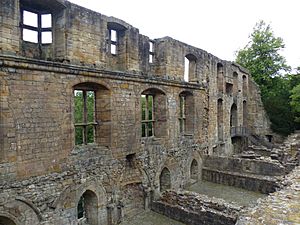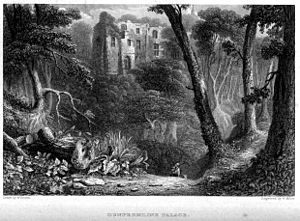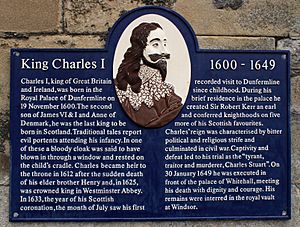Dunfermline Palace facts for kids
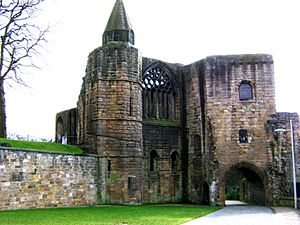
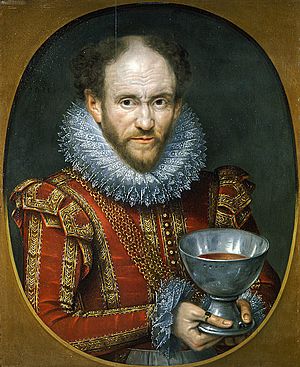
Dunfermline Palace is a historic royal palace in Dunfermline, Fife, Scotland. Today, it is mostly in ruins but remains an important place to visit. It is looked after by Historic Environment Scotland, along with the nearby Dunfermline Abbey.
Contents
The Palace's Beginnings
Dunfermline was a favorite home for many Scottish kings and queens. Royal history here goes back to the 11th century. King Malcolm III made Dunfermline his capital. His home was Malcolm's Tower, a short distance west of where the palace stands now. Later, both King David II and King James I were born in Dunfermline.
Dunfermline Palace is connected to the famous Dunfermline Abbey. It sits between the abbey and a deep valley to the south. A gatehouse and a covered passageway, called a pend, link the palace to the abbey. This pend was one of Dunfermline's old town gates. The palace itself was originally the abbey's guest house.
Not many records exist about how the palace was built or how the abbey's buildings were changed for royal use. We know that King James IV rebuilt and improved the guest house around the year 1500. He often visited the palace and gave money to the builders. Later in the 1500s, the palace was updated again. William Schaw worked on it in 1590 to get it ready for Anne of Denmark.
Royal Life at Dunfermline Palace
Early Royal Stays
King James IV and his wife, Margaret Tudor, often stayed at Dunfermline Palace. In 1504, Queen Margaret was there when people thought the plague might be spreading. She quickly left for Edinburgh with her servants. Luckily, it was a false alarm.
King James V and his second wife, Mary of Guise, also used the palace. In 1562, after dinner at Dunfermline, Mary, Queen of Scots, showed off a beautiful gold ring with a heart-shaped diamond. She said she would send it to Queen Elizabeth with some poems she had written. At this time, the two queens were thinking about meeting each other.
Anne of Denmark's Home
James VI stayed at Dunfermline Palace in June 1585 to avoid the plague in Edinburgh. He even made rules about food and lodging prices for his court in the town. In 1589, the king gave the palace as a wedding gift to his new wife, Anne of Denmark.

Queen Anne gave birth to three of their children at the palace: Elizabeth (1596), and Charles (1600). She sometimes traveled between Edinburgh and Dunfermline by boat. Queen Anne made many improvements to the palace during her time there.
Anne of Denmark was given the lands that used to belong to Dunfermline Abbey. She was known as the "Lady of Dunfermline." In 1596, Alexander Seton was put in charge of the palace and her lands. The palace had many staff members, including a gardener and a plumber who fixed the lead roofs. Queen Anne was entertained by a musician named John Norlie and her jester, Tom Durie.
In 1600, Queen Anne finished building a new part of the palace. It was called the "Queen's House" or "Queen Anna of Denmark's House." This building was very tall and had a driveway running through its bottom floor. It was taken down in 1797. There was also a tennis court in the old abbey area.
Robert, another child of Anne and James, was born at Dunfermline in 1602. The royal nursery at Dunfermline was managed by Margaret Stewart, Mistress of Ochiltree. It is said that a local woman, Margaret MacBeth, helped the queen with herbal medicines during the royal births.
In 1601, Queen Anne prepared a room for her daughter, Princess Elizabeth. However, the princess stayed at Linlithgow Palace instead. In 1602, there was another plague scare in Edinburgh. The Privy Council was worried the sickness would reach the queen and her children. So, they stopped ferry crossings to and from Dunfermline.
Prince Charles's Childhood Home
After King James VI became King of England in 1603, the Scottish court moved to London. This meant the palace was visited less often by the monarch. Prince Charles, who was a sickly child, stayed at Dunfermline for a year.
His guardians were Alexander Seton and his wife, Grissal Leslie. Jean Drummond looked after him, and an older woman, Marion Hepburn, rocked his cradle. Prince Charles was slow to learn to walk. He was given a special wooden stool with wheels to help him practice.
In 1604, a doctor named Dr. Henry Atkins wrote to Queen Anne. He said that Prince Charles could now walk across the "great chamber" many times a day without help. Dr. Atkins said Charles was "like a gallant soldier." Prince Charles left Dunfermline for England on July 17, 1604.
Some of Prince Charles's old servants from Dunfermline went to England with him and received pensions. In 1618, a poet named John Taylor stayed at the palace. He described it as "a delicate and princely mansion" with "fair gardens, orchards, meadows."
When Anne of Denmark passed away in 1619, ownership of the palace went to Prince Charles. The "new great house" built by his mother was repaired. In 1624, a fire badly damaged the town of Dunfermline, and Prince Charles sent money to help.
Later Royal Visits and Decline
In 1633, King Charles I returned to Scotland for his coronation. He made only a short visit to Dunfermline, his birthplace. The last king to stay at the palace was Charles II. He was there in 1650, just before the Battle of Pitreavie.
Soon after, during the time when Oliver Cromwell's army occupied Scotland, the palace was left empty. By 1708, its roof had been removed.
Today, all that remains of the palace are the kitchen, its cellars, and the large south wall. This wall offers a great view over the Firth of Forth to the south.
See also
 In Spanish: Palacio de Dunfermline para niños
In Spanish: Palacio de Dunfermline para niños



